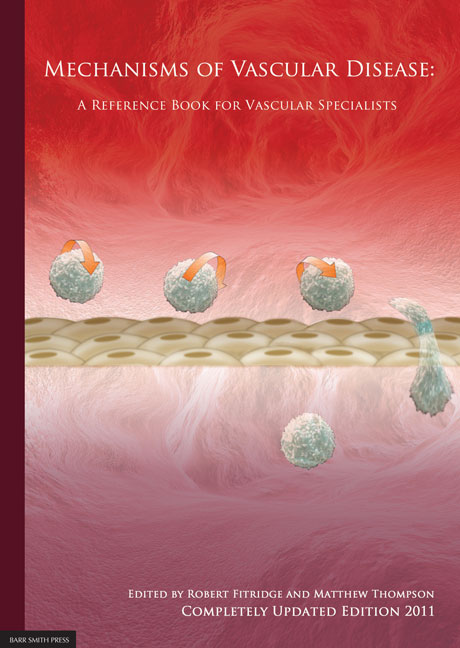Book contents
- Frontmatter
- Contents
- List of Contributors
- Detailed Contents
- Acknowledgements
- Abbreviation List
- 1 Endothelium
- 2 Vascular smooth muscle structure and function
- 3 Atherosclerosis
- 4 Mechanisms of plaque rupture
- 5 Current and emerging therapies in atheroprotection
- 6 Molecular approaches to revascularisation in peripheral vascular disease
- 7 Biology of restenosis and targets for intervention
- 8 Vascular arterial haemodynamics
- 9 Physiological Haemostasis
- 10 Hypercoagulable States
- 11 Platelets in the pathogenesis of vascular disease and their role as a therapeutic target
- 12 Pathogenesis of aortic aneurysms
- 13 Pharmacological treatment of aneurysms
- 14 Pathophysiology of Aortic dissection and connective tissue disorders
- 15 Biomarkers in vascular disease
- 16 Pathophysiology and principles of management of vasculitis and Raynaud's phenomenon
- 17 SIRS, sepsis and multiorgan failure
- 18 Pathophysiology of reperfusion injury
- 19 Compartment syndromes
- 20 Pathophysiology of pain
- 21 Post-amputation pain
- 22 Treatment of neuropathic pain
- 23 Principles of wound healing
- 24 Pathophysiology and principles of varicose veins
- 25 Chronic venous insufficiency and leg ulceration: Principles and vascular biology
- 26 Pathophysiology and principles of management of the diabetic foot
- 27 Lymphoedema – Principles, genetics and pathophysiology
- 28 Graft materials past and future
- 29 Pathophysiology of vascular graft infections
- Index
2 - Vascular smooth muscle structure and function
Published online by Cambridge University Press: 05 June 2012
- Frontmatter
- Contents
- List of Contributors
- Detailed Contents
- Acknowledgements
- Abbreviation List
- 1 Endothelium
- 2 Vascular smooth muscle structure and function
- 3 Atherosclerosis
- 4 Mechanisms of plaque rupture
- 5 Current and emerging therapies in atheroprotection
- 6 Molecular approaches to revascularisation in peripheral vascular disease
- 7 Biology of restenosis and targets for intervention
- 8 Vascular arterial haemodynamics
- 9 Physiological Haemostasis
- 10 Hypercoagulable States
- 11 Platelets in the pathogenesis of vascular disease and their role as a therapeutic target
- 12 Pathogenesis of aortic aneurysms
- 13 Pharmacological treatment of aneurysms
- 14 Pathophysiology of Aortic dissection and connective tissue disorders
- 15 Biomarkers in vascular disease
- 16 Pathophysiology and principles of management of vasculitis and Raynaud's phenomenon
- 17 SIRS, sepsis and multiorgan failure
- 18 Pathophysiology of reperfusion injury
- 19 Compartment syndromes
- 20 Pathophysiology of pain
- 21 Post-amputation pain
- 22 Treatment of neuropathic pain
- 23 Principles of wound healing
- 24 Pathophysiology and principles of varicose veins
- 25 Chronic venous insufficiency and leg ulceration: Principles and vascular biology
- 26 Pathophysiology and principles of management of the diabetic foot
- 27 Lymphoedema – Principles, genetics and pathophysiology
- 28 Graft materials past and future
- 29 Pathophysiology of vascular graft infections
- Index
Summary
INTRODUCTION
Smooth muscle has an important role in regulating the function of a variety of hollow organ systems including the: vasculature, airways, gastrointestinal tract, uterus and reproductive tract, bladder and urethra and several other systems. Smooth muscle has two fundamental roles: 1) to alter the shape of an organ and 2) to withstand the force of an internal load presented to that organ. In order to achieve these fundamental objectives smooth muscles have developed mechanisms of mechanical coupling, which enable the development of powerful and coordinated contractions at a relatively low energy cost. For example, smooth muscle in the gastrointestinal tract must undergo intermittent but coordinated phasic contractions to propel the bolus of food through the alimentary canal. Whereas in the airways and vasculature the smooth muscle is more often in various states of tonic contraction, but can be dynamically regulated to relax or contract in response to specific neuro-hormonal and haemodynamic signals. In keeping with the aims of this text, this chapter will focus on the principle mechanisms through which vascular smooth muscle functions.
SMOOTH MUSCLE (VASCULAR) STRUCTURE
Vascular smooth muscle cells have classically been envisaged as fusiform cells, on average 200 microns long × 5 microns in diameter, with a large central nucleus surrounded by an abundant array of endoplasmic reticulum and golgi apparatus, with the cytosol and plasma membrane tapering toward the poles. Although the dimensions of the vascular smooth muscle cell narrow toward their ends there is clear evidence that the end-to-end junctions coupling smooth muscle cells are complex and contain a significant number of membrane invaginations to provide increased surface area for both mechanical tight junctions and electrical coupling via gap junctions (Figure 2.1).
- Type
- Chapter
- Information
- Mechanisms of Vascular DiseaseA Reference Book for Vascular Specialists, pp. 13 - 24Publisher: The University of Adelaide PressPrint publication year: 2011
- 6
- Cited by



